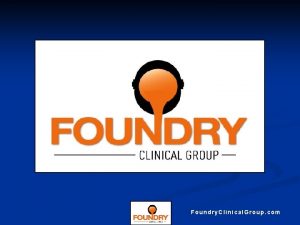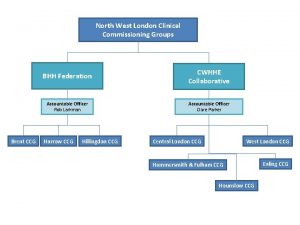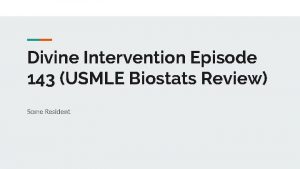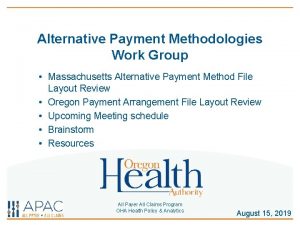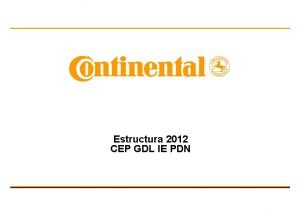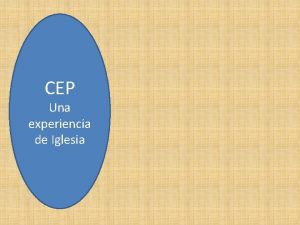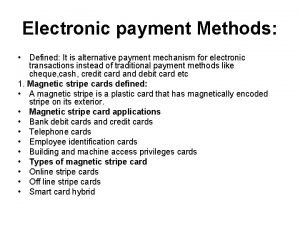CEP Work Group 1 Clinical Episode Payment CEP




















- Slides: 20

CEP Work Group 1 Clinical Episode Payment (CEP) 19 Members Chair Lewis Sandy, MD, MBA Senior Vice President, Clinical Advancement, United. Health Group The group will identify the most important elements of clinical episode payment models for which alignment across public and private payers could accelerate the adoption of these models nationally. The emphasis will be on identification of best practices to provide guidance to organizations implementing clinical episode payment models. Key Activities ü Identifying the elements for elective joint replacement, maternity, and cardiac care episode payments ü Identifying best practices for implementing clinical episode payment models

CEP Members 2 Member Roster Lewis Sandy, MD, MBA Executive Vice President, Clinical Advancement, United. Health Group Amy Bassano, MPP Director, Patient Care Models Group, Centers for Medicare and Medicaid Services Edward Bassin, Ph. D Chief Analytics Officer, Archway Health Brooks Daverman, MPP Director of the Strategic Planning and Innovation Group, Tennessee Division of Health Care Finance and Administration François de Brantes, MS, MBA Executive Director, Health Care Incentives Improvement Institute, Inc. Mark Froimson, MD, MBA Executive Vice President and Chief Clinical Officer Trinity Health, Inc. Cara Osborne MSN, CNM, Sc. D Chief Clinical Officer, Baby+Co. Dale Paton Reisner, MD Maternal Fetal Medicine Specialist Swedish Medical Center Carol Sakala, Ph. D, MSPH Director of Childbirth Connection Programs National Partnership for Women & Families Richard Shonk, MD, Ph. D Chief Medical Officer, the Health Collaborative John Bertko, FSA, MAAA Chief Actuary, Covered California Rob Lazerow Practice Manager, Research and Insights The Advisory Board Company Kevin Bozic, MD Chair of Surgery and Perioperative Care, Dell Medical School at the University of Texas at Austin Catherine Mac. Lean, MD, Ph. D Chief Value Medical Officer, Hospital for Special Surgery Barbara Wachsman Chair, Pacific Business Group on Health Alexandra Clyde, MS Corporate Vice President of Global Health Policy, Reimbursement and Health Economics, Medtronic, Inc Jennifer Malin, MD, Ph. D Staff Vice President, Clinical Strategy, Anthem, Inc. Jason Wasfy, MD Director, Mass General Heart Center Steve Spaulding Senior Vice President, Enterprise Networks Arkansas Blue. Cross Blue. Shield

Accelerating and Aligning for CEP models The white paper titled Accelerating and Aligning Clinical Episode Payment Models provides high-level recommendations for designing clinical episode payment models. A clinical episode payment is a bundled payment for a set of services that occur over time and across settings. The paper outlines design elements and operational considerations for three selected clinical areas: elective joint replacement, maternity care, and coronary artery disease. Recommendations are organized according to design elements and operational considerations. Design elements address questions stakeholders must consider when designing an episode payment model, including the definition, the duration of the episode, what services are to be included, and others. Operational considerations relate to implementing an episode payment model, including the roles and perspectives of stakeholders, data infrastructure issues, and the regulatory environment in which APMs must operate. The recommendations are designed to speak to a multistakeholder audience with the goal of supporting broad clinical episode payment adoption. Development December 2015 – February 2016 Draft Release February 26, 2016 Public Comment February 26 – March 28, 2016 Revise March 28 – July 25, 2016 Final Release August 1, 2016 3

Episode Selection Criteria $ Empowering Consumers High Volume, High Cost Conditions and procedures with opportunities to engage patients and family caregivers through the use of decision aids support for shared decision-making; goal setting and support for identifying high-value providers. Conditions and procedures for which high cost is due to non-clinical factors such as inappropriate service utilization and poor care coordination that correlate with avoidable complications, hospital readmissions, and poor patient outcomes. 4 Unexplained Variation Conditions and procedures for which there is high variation in the care that patients receive, despite the existence evidence based “best” practices. Care Trajectory Conditions and procedures for which there is a wellestablished care trajectory, which would facilitate defining the episode start, length, and bundle of services to be included. Availability of Quality Measures Conditions and procedures with availability of performance measures that providers must meet in order to share savings, which will eliminate the potential to incentivize reductions in appropriate levels of care.

Episode Parameters Episode Design and Operational Considerations 5 Stakeholder Perspectives: Ensure that the voices of all stakeholders – consumers, patients, providers, payers, states and purchasers – are heard in the design and operation of episode payments Data Infrastructure: Understand develop the systems that are needed to successfully operationalize episode payments Regulatory Environment: Recognize and understand relevant state and/or federal regulations, and understand how they support or potentially impede episode payment implementation Interaction between multiple APMs: Recognize questions and issues that may arise when determining how to implement episode payment together with other alternative payment models, such as population-based payment

Clinical Episode Timing 6 Generic Timeline for Episode Payments Starting Point Episode Duration Prior to date of intervention Shared Decision Making functional status tools & decision aids Stopping Point Timeframe following date of intervention Pre-Procedure Event Post-Procedure 30 days* 2 -5 days* 90+ days* * Varies based on episode. For illustrative purposes only Track Quality Measures

Retrospective Steps Conduct Episode Pay Providers Reconcile Payments Distribute Savings/Overages 7 Role Process Distributes Payment Health Plans/ Payers Providers Health Plans/ Payers & Providers (based on fee schedule) Pre-Procedure Event Post-Procedure Provider #1 Orthopedist Provider #2 Hospital Provider #3 Rehabilitation Center 2 1 3 8 5 4 6 7 10 9 Distribute Savings/Cost (based on negotiated agreement) Total Cost of Services Reconciled (across population of episodes)

Prospective Steps Conduct Episode Pay Provider Reconcile Payments Manage Savings/Overages 8 Role Health Plans/ Payers Providers Process Single Upfront Payment (for entire episode) Distribute Payment Pre-Procedure Event Post-Procedure Provider #1 Orthopedist Provider #2 Hospital Provider #3 Rehabilitation Center Total Cost of Services Reconciled (across the health system) Manage Savings/Cost (upside/downside risk)

Retrospective vs. Prospective Retrospective Reconciliation Steps Role Process Prospective Payment Role Distributes Payment Conduct Episode Health Plans/Payers (based on fee schedule) 9 Process Single Upfront Payment Health Plans/ Payers (for entire episode) Payment Distributed (across health system) Pay Providers Total Cost of Services Reconciled Reconcile Payments Manage Savings/Overages Providers (across population of episodes) Health Plans/ Payers & Providers Distribute Savings/Cost (based on negotiated agreement) Total Cost of Services Reconciled Providers (across health system) Manage Savings/Cost (upside/downside risk) Providers

Elective Joint Replacement Elective hip and knee replacement for CEP models The white paper titled Accelerating and Aligning Clinical Episode Payment Models provides highlevel recommendations for designing clinical episode payment models. A clinical episode payment is a bundled payment for a set of services that occur over time and across settings. The paper outlines design elements and operational considerations for three selected clinical areas: elective joint replacement, maternity care, and coronary artery disease. The elective joint replacement recommendations emphasize using functional status assessments (both pre- and post-procedure) and shared decision-making tools to determine whether a joint replacement is the appropriate treatment for a given patient. The recommendations are designed to speak to a multi-stakeholder audience with the goal of supporting broad clinical episode payment adoption. Development December 2015 – February 2016 Draft Release February 26, 2016 Public Comment February 26 – March 28, 2016 Revise March 28 – July 25, 2016 Final Release August 1, 2016 10

Elective Joint Replacement – Design Elements 11 Summary of Elective Joint Replacement Episode Recommendations Design Elements 1. Episode Definition 2. Episode Timing 3. Patient Population 4. Services 5. Patient Engagement Elective & appropriate total hip and total knee replacement due to osteoarthritis Start pre-procedure and end 90 d. post-discharge, and meet requirements Broadest-possible pool of patients with risk/severity adjusted All services needed by the patient related to the joint replacement procedure Patient engagement tools and supports should be available at all stages of care, including transparent cost & care info 9. Type and Level of Risk 6. Accountable Entity 7. Payment Flow 8. Episode Price Provider best able to engineer change in the way care is delivered to the patient, and able to accept risk. The orthopedic surgeon may fit this role, as may other clinicians Payment flow –either retrospective reconciliation or prospective payment – depends on unique characteristics of the models’ players. However, prospective payment is recommended for TJR Balance single and multiple providers, and regional utilization history. Reflect the cost of services needed to achieve the goals of the episode payment model Upside reward and/or downside risk, depending on the model 10. Quality Metrics Clinical and Patient. Reported Outcome measures; use of quality measurement for payment and accountability

Elective Joint Replacement Timeline 12 Episode Timeline for Elective Joint Replacement Determination of Appropriateness of Elective Procedure “triggers” starting point Starting Point Stopping Point Episode Duration Pre-procedure, with enough time for diagnostics and pre-conditioning Pre-operative Surgical Visit Pre-operative Preparation & Planning ~ 30 for example 90 days post-discharge Preparation, Operation and PACU Inpatient Stay & Discharge Process Post-discharge Rehabilitation & Follow-up Care ~ 6 hours ~ 3 days 12 months Track Quality Measures Shared Decision Making to determine appropriateness of procedure, and throughout the episode. Source: Derived from Premier, Inc. , and Institute for Healthcare Improvement. Integrated Care Pathway for Total Joint Arthroplasty. Charlotte, NC: Premier, Inc. and Cambridge, MA: Institute for Healthcare Improvement; 2013. (Available at www. premierinc. com and www. ihi. org)

Maternity Care for CEP models The white paper titled Accelerating and Aligning Clinical Episode Payment Models provides high-level recommendations for designing clinical episode payment models. A clinical episode payment is a bundled payment for a set of services that occur over time and across settings. The paper outlines design elements and operational considerations for three selected clinical areas: elective joint replacement, maternity care, and coronary artery disease. The maternity care recommendations outlined in this chapter emphasize the need for patient engagement, education, and parenting support services (in addition to clinical maternity care), to achieve a number of critical goals. These include increasing the percentage of full-term births and the percentage of vaginal births, while decreasing the percentage of pre-term and early elective births, complications, and mortality. They are designed to speak to a multi-stakeholder audience with the goal of supporting broad clinical episode payment adoption. Development February – April 2016 Draft Release April 22, 2016 Public Comment April 22 – May 23, 2016 Revise May 23 – July 25, 2016 Final Release August 1, 2016 13

Maternity Care – Design Elements 14 Summary of Maternity Care Episode Recommendations 1. Episode Definition 2. Episode Timing Design Elements 3. Patient Population Episode includes maternity Episode begins 40 weeks The population is women and newborn care for the before the birth and ends and newborns who are lower majority of pregnancies that 60 days postpartum for the -risk, as well as women who are lower risk, as well as for woman, and 30 days post- may be at elevated risk due women with elevated risk birth for the baby. to conditions with defined conditions for which there and predictable care defined and predictable care trajectories. 6. Accountable Entity 7. Payment Flow 8. Episode Price 4. Services 5. Patient Engagement All services provided during Engage women and their pregnancy, labor and birth, families in all three phases of and the postpartum period the episode (prenatal, labor (for women); and newborn and birth, and care for the baby. Pediatric postpartum/newborn). services are not included. Other service exclusions should be limited. 9. Type and Level of Risk 10. Quality Metrics Accountable entity chosen Payment flow – either The episode price should Ultimate goal is both upside Prioritize use of metrics that based on readiness to both re retrospective reconciliation balance single and multiple reward and downside support the episode goals, -engineer change in the way or prospective payment – providers and regional risk, with strategies in place including measures of clinical care is delivered to the depends on the unique utilization history. It should to mitigate risk, encourage outcomes and patient, and to accept risk. characteristics of the reflect the cost of services provider participation, and reported outcomes, for use Shared accountability may be model’s players. needed to achieve the goals support inclusion of a broad in payment, accountability, required, given that a patient of the episode payment patient population. . quality scorecards, and other may be cared for by multiple model. tools to communicate with practitioners across and engage patients and multiple settings. other stakeholders.

Maternity Care – Timeline 15 Episode Timeline for Prenatal through Postpartum Care Goals Birth Starting Point Episode Duration ~ 40 weeks prior or pregnancy Prenatal ~ 40 weeks Services (Examples) Reimbursable Services Directly Related • • • Monthly prenatal visits Routine ultrasound Blood testing Diabetes testing Genetic testing Stopping Point Post 37 weeks for low-risk pregnancies Not Typically Reimbursed NOT Directly Related • Doulas • Care coordinators • Group education meetings • Childbirth education classes • Preventive screenings (chlamydia, cervical cancer) ~ 60 days post-birth Labor & Birth Postpartum ~ 2 -10 days ~ 60 days (mother) ~ 30 days (baby) • Labor and Birth • Breastfeeding support • Depression screening • Contraception planning • Ensuring link from birth to pediatric care provider occurs Use of evidence-based care to achieve woman- and familycentered care Improving coordination across providers, settings, and maternity care Track Quality Measures Increase: • % of full-term births • % of vaginal births Decrease: • % of pre-term and elective births • % of C-sections • Complications and mortality (inc. readmission & levels of NICU use)

Coronary Artery Disease for CEP models The white paper titled Accelerating and Aligning Clinical Episode Payment Models provides high-level recommendations for designing clinical episode payment models. A clinical episode payment is a bundled payment for a set of services that occur over time and across settings. The paper outlines design elements and operational considerations for three selected clinical areas: elective joint replacement, maternity care, and coronary artery disease. Episode payment for CAD establishes a budget that incentivizes the providers managing the patient to more appropriately balance the needs of the patient and the number and type of services provided. Placing accountability for the entire condition with a designated provider also encourages the active management of the patient in order to prevent acute events that lead to worsening health, further procedures, and an increased risk of overall poor outcomes. The goal of person-centered episode payment is to make the patient the focus of care management, ensuring that any efficiencies achieved through improved care coordination and management first and foremost benefit the patient. Development February – April 2016 Draft Release May 20, 2016 Public Comment May 20 – June 20, 2016 Revise June 20 – July 25, 2016 Final Release August 1, 2016 16

Coronary Artery Disease – Episode Design 17 Summary of Coronary Artery Disease Episode Recommendations 1. Episode Definition Condition: 12 months of active CAD management Procedure: PCI or CABG for treatment of CAD Design Elements 2. Episode Timing Condition: Parallel to benefit year Procedure: Pre-op, procedure, and 30 -90 days post-discharge 3. Patient Population Condition: Patients diagnosed with CAD and in same health plan for full 12 months Procedure: Patients deemed to need a PCI or CABG based on appropriate use guidelines 6. Accountable Entity 7. Payment Flow 8. Episode Price Condition: Cardiologist and/or PCP accountable for condition and for overall episode Procedure: Intensivist or cardiothoracic surgeon Both: Payment flow – either upfront FFS or prospective payment – depends on the unique characteristics of the model’s players. Both: Balance regional/multi-provider and provider-specific utilization history; Acknowledge efficiencies; be feasible to attain 4. Services 5. Patient Engagement Both: Core services for Both: Patient education CAD management and self-management for quality delivery of tools, patient and family procedure. engagement in care planning and care transitions; shared decision-making 9. Type and Level of Risk Both: Upside and/or downside risk, depending on the model. 10. Quality Metrics Both: Clinical and patientreported outcomes; including functional status Procedure: Process and outcome measures

Fragmentation Of Care 18 For Coronary Artery Disease Primary Care In-patient & Out-patient Hospital Specialty Care Home Health Lack of Appropriate Follow-up Testing Diagnostic Errors Hospice Post-acute Care Hospital Readmission Adverse Drug Events

Coronary Artery Disease – Timeline 19 Episode Timing for Percutaneous Coronary Intervention (PCI) and Coronary Artery Bypass Graft (CABG) Starting Point Stopping Point Episode Duration Diagnosis by non-acute event OR acute event ~ 12 months Active Management of Coronary Artery Disease PCI/CABG Active Management of Coronary Artery Disease Services: Diagnostic, preventative care, medication management, care management, and lifestyle change support ~ 12 month period (first episode may be shorter, depending on start point) 0 30 60 Pre. Operative Procedure Post Discharge varies ~ 30 -90 days 90

Coronary Artery Disease – Price & Care 20 Why a Nested Cardiac Care Episode? Type of Care CAD Condition Management Primary Care Provider or Cardiologist Procedure is determined appropriate by Heart Team (Cardiologist, PCP, cardiothoracic surgeon, cardiac anesthesiologist, hospitalist) using data and Appropriate Use Criteria Inpatient & Outpatient Hospital Active Management of Coronary Artery Disease PCI/ CABG Nested Episode Design Interventionalist (PCI) or Cardiothoracic Surgeon (CABG) ü Incentive to coordinate care delivery since both parties are at risk financially ü Make value-based decisions – using quality measures and historical costs – when partnering Additional clinicians and settings involved in CAD Care: CCC Cath Lab, Cardiac Rehabilitation Facility, others.
 Asvab access code
Asvab access code Asvap
Asvap Group work objectives
Group work objectives Work group vs work team
Work group vs work team Smart work vs hard work group discussion
Smart work vs hard work group discussion Payment systems and working hours
Payment systems and working hours The foundry mft
The foundry mft Whole health clinical group
Whole health clinical group North west london ccg
North west london ccg Croydon clinical commissioning group
Croydon clinical commissioning group Verbal irony in movies
Verbal irony in movies New grilling technology cuts production time in half
New grilling technology cuts production time in half Writing a personal narrative episode 1
Writing a personal narrative episode 1 Oedipus rex episode 3 summary
Oedipus rex episode 3 summary Exodus oedipus rex summary
Exodus oedipus rex summary Happy
Happy Episode the baby project
Episode the baby project Generalization and example pattern organizer example
Generalization and example pattern organizer example La catrina restaurante
La catrina restaurante Episode 901 review answers
Episode 901 review answers Biostats step 3
Biostats step 3






